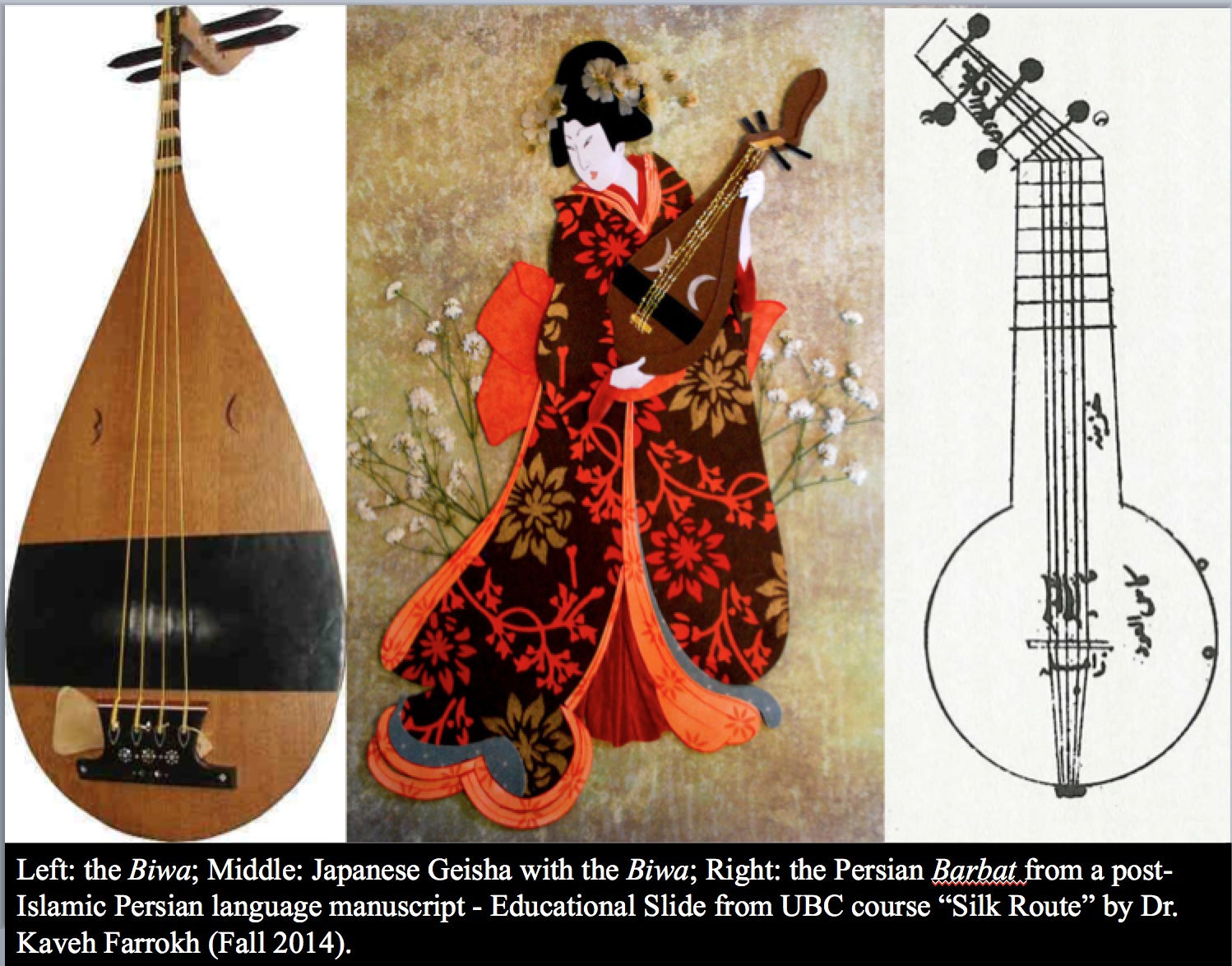For more on these topics kindly see: Languages, Literature and the Arts
===============================================================
In the narrowest sense, music history deals with notated or recorded material that can be traced back some centuries . But in a wider sense it comprises all musical culture, and this history spans a vastly longer period, which in Iran comprises five millennia. The documentation is largely archeological with a sprinkling of textual sources, and some evidence is here assembled to outline Iran’s pre-Islamic music history.
Iran proper includes Afghanistan with its strong political and linguistic ties to the center. But Iranian languages and culture spread to the much wider region of greater Iran (Frye, p. 3; FIGURE 1), comprising parts of Transcaucasia, Central Asia, northwest India, Mesopotamia, as well as Iran and Afghanistan.
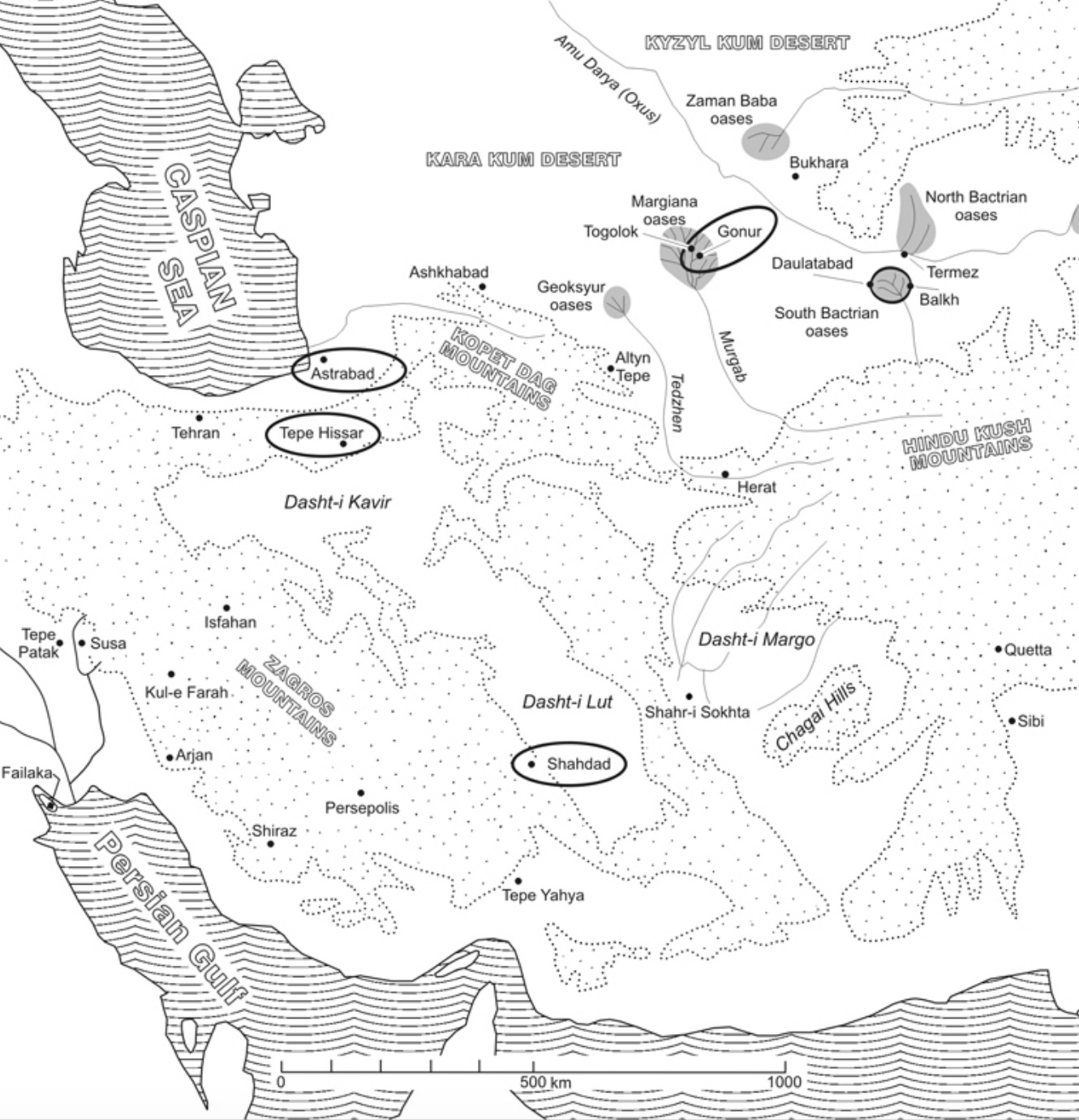
Figure 1: The Iranian cultural area (Encyclopedia Iranica).
Iran proper exhibited a cultural split between its eastern and western parts. Between 2350 and 650 B.C.E. Elam was the principal state in western Iran, and its capital was Susa. Elam was culturally and politically affected by the nearby Mesopotamian polities. Eastern Iran came to the forefront around 2000 B.C.E. with the Oxus trumpet, while around 600 C.E. the Far East began to show musical scenes derived from Sogdia, a region north of Iran proper but with cultural affinities to its southern neighbor.
Third Millennium B.C.E.
(1) Arched harps in western Iran
They were the first complex instruments to appear in the archeological records (FIGURE 2a), and Iran was the apparent birthplace (3300-3100 B.C.E.), although Mesopotamia was not far behind (3000 B.C.E.). Since the dates are close and the representations few, it is not possible to determine the region of origin.
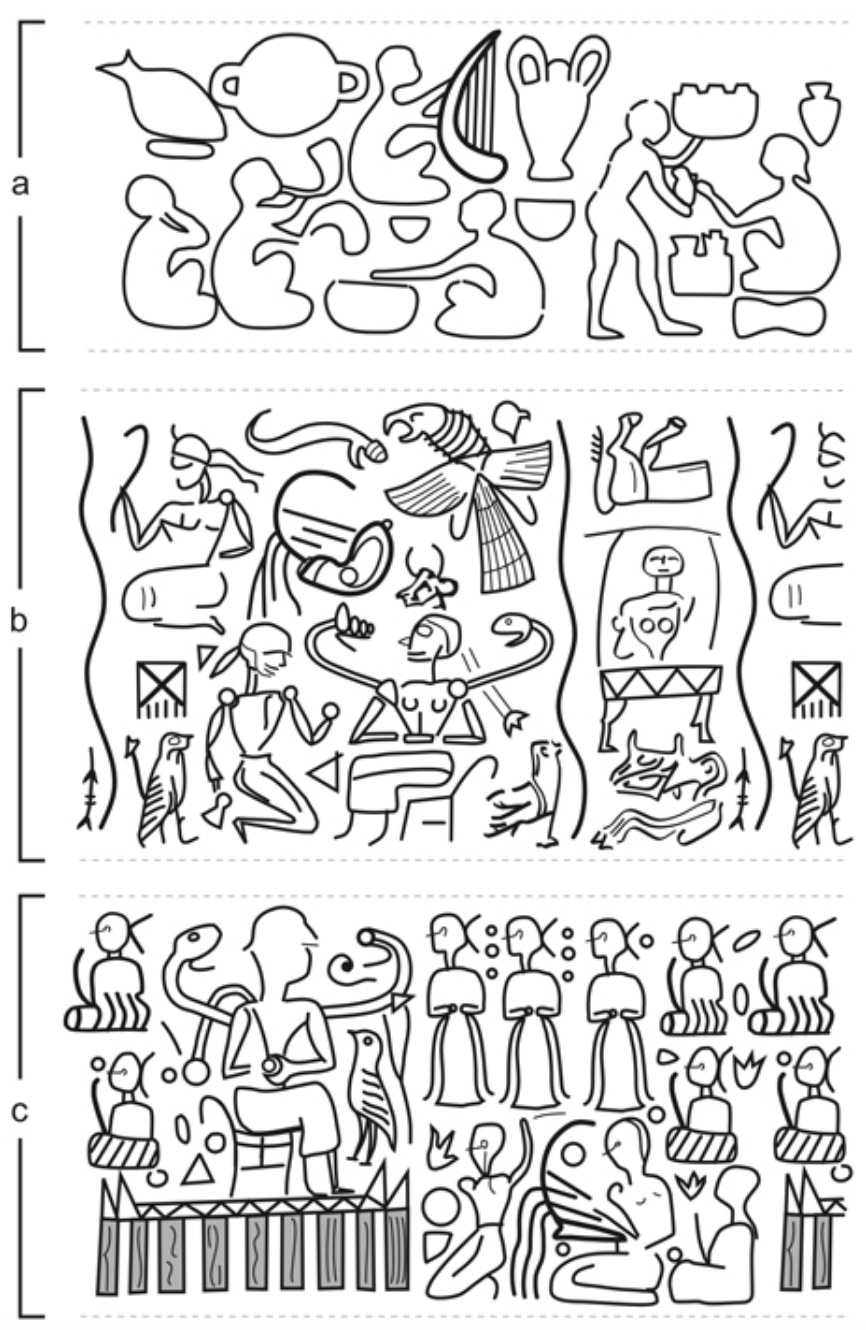
Figures 2a-2c: Arched harps on Iranian seal impressions from the 3rd millennium B.C.E. (Lawergren, “Iran,” fig. 3) (Encyclopedia Iranica).
The harps’ context differed in Iran and Mesopotamia. During the 3rd millennium, Iranian representations show harps in complex rituals. A seal from the turn of the 4th millennium (FIGURE 2a) shows a harper who performs with a drummer, a singer, and a wind player, surrounded by pots. Their large variety seems to lend a complexity to the pictorial composition that goes well beyond a simple meal eaten by the person seated at the right side. The harp on a seal from the middle of the 3rd millennium (FIGURE 2b) appears in a scene crowded with humans, gods, snakes, birds, animal parts, and flora. E. Porada (pp. 41-42) attempted an iconographic analysis, but the exact meaning remains elusive. The main figure is a seated goddess with snakes rising from her shoulders, and the harp above her head lacks a player. Apparently, harp and rite were so strongly linked that it was unnecessary to show the player; perhaps the harp had already acquired a symbolic function. (Today, of course, symbolic functions of instruments are ubiquitous, as in the allusion to lyres in ‘lyric poetry.’) Many of these elements, including the snake divinity, are also present on the seal from the second half of the 3rd millennium (FIGURE 2c). The harpist sits near a table that supports the divinity.
In Mesopotamia, harps were shown in less complex rituals in which they accompanied officiants bringing offerings to kings and gods (Rashid, pls. 29, 32, and 33). Such musical presentation scenes became popular throughout the Near East, west of Iran.
After the 3rd millennium, arched harps disappeared from Iran, though they continued to flourish in Egypt and India (Lawergren, “Harp,” secs. 3iii and 3v). They were replaced by angular harps.
(2) Bull lyres in western Iran
They are large lyres with a bull’s head on one side, and flourished primarily in Mesopotamia. Extant instruments and images are dated 2450 B.C.E. (FIGURE 3a and 3c; see Rashid, pp. 29-41). But nearly identical instruments were used in the east, in Susa (FIGURE 3d), in the south, in Failaka (FIGURE 3e), and in the northwest, in Mari (FIGURE 3b). Not only did the instruments spread from Mesopotamia, but so did the strong association between animals and music, since some players were disguised as animals.
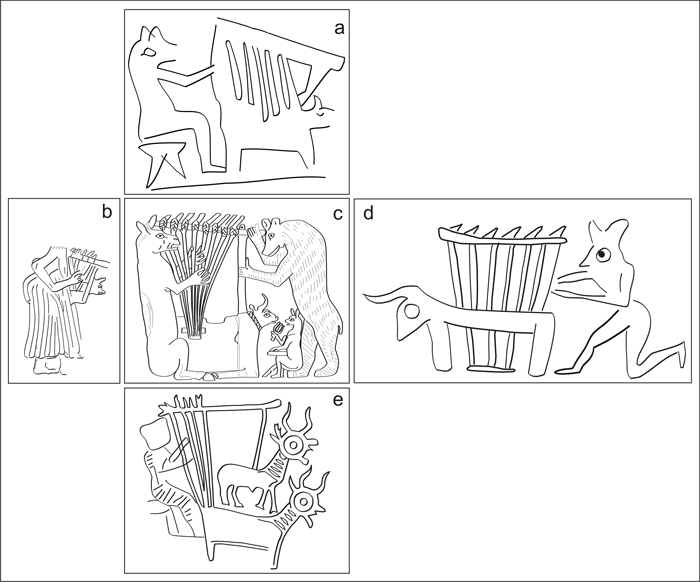
Figures 3a-3e: Bull lyres of the 3rd millennium B.C.E. a. Cylinder sael from Farah, southern Mesopotamia, ca. 2600 (Spycket, fig. 10b). b. Engraved shell from Mari, eastern Syria (Parrot, pl. LX, no. 2459). c. Inlaid plaque on the side of an extant lyre from Ur, southern Mesopotamia, 2450. (Lawergren, “Iran,”fig. 4a). d. Cylinder seal from Susa, western Iran (Lawergren, “Iran,” fig. 4b). e. Seal from Failaka, northern Persian Gulf, ca. 1900 (Lawergren, “Iran,” fig. 4c) (Encyclopedia Iranica).
The lyre distribution attests to the dominance of Mesopotamian musical culture in the second half of the 3rd millennium. Although many Mesopotamian texts deal with musical instruments, the Sumerian name of the bull-lyre is not clear, and possible references are uncertain. However, some instruments were said to sound like wild bulls who lock horns and low. In general, bulls held a prominent place in Mesopotamian mythology, as is shown by many non-musical scenes (e.g., Black and Green, pp. 47-51).
Outside Mesopotamian representations are often small and crudely drawn so that it is impossible to distinguish Iranian and Mesopotamian bull-lyres. The latter were often shown as bulls, but the three-dimensional effect is lost when bull-lyres are reconstructed with flat sides in the museums—as is now always the case.
(3) Oxus trumpets in eastern Iran, 2200-1750 B.C.E.
About 40 small trumpets from oases in Bactria and Margiana have recently been brought to light by looters in southern Uzbekistan and northern Afghanistan (FIGURE 1). They are much shorter than modern instruments despite their similar shape: a pipe that has a narrow mouthpiece and ends with a wide flaring bell. Most are made of silver, some of gold, and a few of copper. Fortunately, similar trumpets were also found in scientific excavations in the large region between Margiana in the north and Shahdād in southern Iran (marked on FIGURE 1). These instruments have an archeological context, and the trumpets are now associated with the Bactrian-Margiana Archeological Complex (BMAC) and dated 2200-1750 B.C.E. (Hiebert, p. 376). The objects in the assemblage were probably introduced in Bactria and Margiana, and some spread south into Iran proper (Lawergren, 2003a, p. 66).
Only three distinct types are known for these trumpets (FIGURE 4). The first is a plain trumpet that has a pipe with conical or exponential flare. The mouthpiece is set off from the narrow pipe. The total length is 6 to 16 cm, the wide end is 2 to 6 cm. The second is called bulb trumpet because a bulbous expansion is placed halfway between mouth-piece and bell. Otherwise it is similar to the plain model.
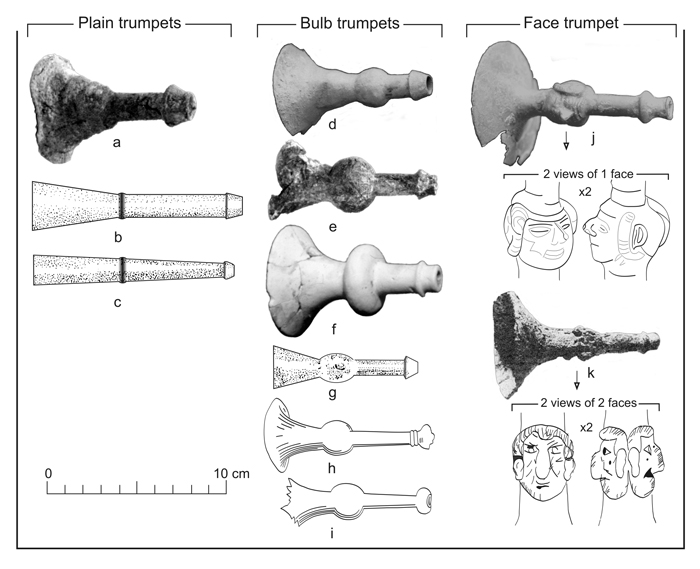
Figure 4: Excavated trumpets, 2200–1750 B.C.E. (Lawergren, 2003a, fig. 3). The line drawing of the faces are shown doubly magnified. a. Shaft grave (cenotaph) at Gonur, Margiana. b, c. Tepe Hissar, Iran. d, e, f. Shaft grave (cenotaph) at Gonur, Margiana. g. Tepe Hissar, Iran. h, i. Astarābād, Iran. j. Shaft grave (cenotaph) at Gonur, Margiana. k. Grave 081 at Shahdād, Iran (Encyclopedia Iranica).
The third type is the face trumpet. It resembles the last type, but has one or several faces modeled on top of the bulb (FIGURE 4j-k, and FIGURE 5a-c and e-f), though the faces can also be placed at the mouthpiece (FIGURE 5d). On one instrument (FIGURE 5c), the three bulb faces have a hair-like structure at the back, and show a young (α), middle-aged (β), and old man (γ). The most complex composition has three bison faces (FIGURE 5f) on a bulb made of one-millimeter thick gold sheet and mounted on top of a copper body. Most likely, the copper served to strengthen the gold. It is a masterpiece of extraordinary technique and life-like character.
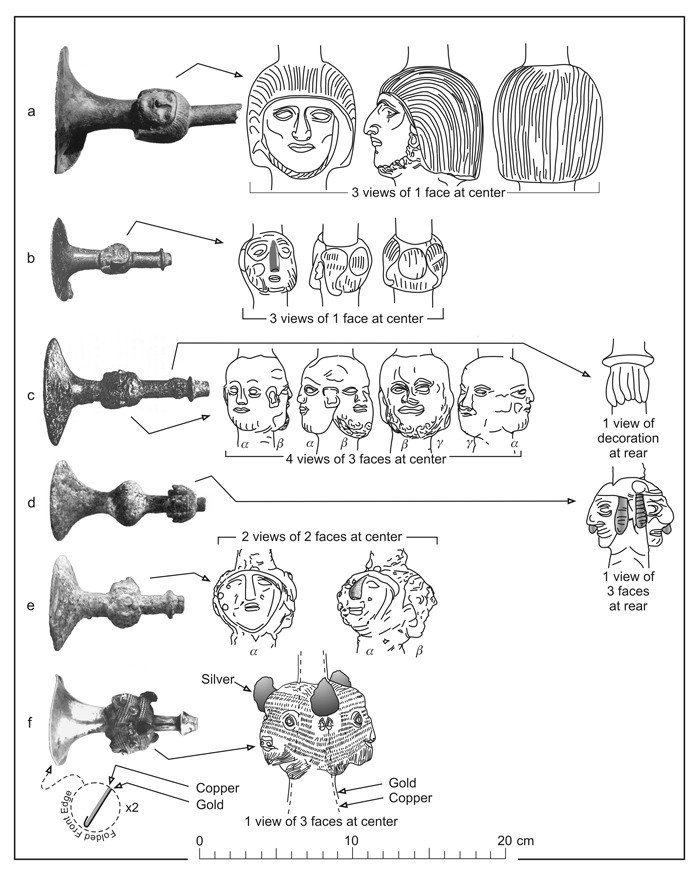
Figure 5a-5f: Unexcavated face trumpets, 2200–1750 B.C.E. (Lawergren, 2003a, fig. 8). The line drawings, given at twice that scale, show the faces from several directions, and faces close to the mouthpiece at the right in the picture, while those located in the middle are in the center. a. Man. b. Man. c. Three men near the midpoint (α-γ) and a decoration near the mouthpiece. d. Three undeterminable faces. e. Two faces (α-β). f. Three bison faces (Encyclopedia Iranica).
Since the instruments are much smaller than today’s trumpets, some scholars have given alternative interpretations, arguing that these objects were stands, funnels, or sprouts. But such mundane objects would hardly use precious materials and extraordinary workmanship. A. Hakemi (p. 635) considers an instrument that he excavated (FIGURE 4k the front piece joined to a now decayed long wooden tube. The composite object would have a steady and powerful tone like a modern trumpet.
There is, however, no need to introduce this speculative construction because the short trumpets function well without such extension. If pressed against the lips and blown, the instrument produces a high-pitched sound near C, two octaves higher than the so-called middle-C. Because the air mass inside this short trumpet is small, lip vibrations influence the sound more easily than on a modern long instrument, and lip tension can easily change the pitch. The trumpet can imitate the sliding character of animal calls, in particular that of deer. During the rutting season, female deer utter attract male deer with such sounds. If these trumpets were used to call male deer, they would be utilitarian tools rather than musical instruments.
The clue to their use lies in the Zoroastrian text Vendīdād (Lawergren, “Western Influences,” p. 94), which tells of Yima, mankind’s first king. He reigned during the golden age when weather was fair, and sickness or death unknown. But a severe winter set in, and Yima’s god Ahura Mazdā ordered him to bring plants, animals and humans to an underground shelter, while providing two implements to accomplish this task: a golden sufrā and a gold-plated aštrā. These terms are usually translated as “goad” and “whip,” respectively (e.g., Boyce, Textual Sources, p. 94), though J. Duchesne-Guillemin (“Cor de Yima,” esp. pp. 540-41) has shown that the sufrā was, in fact, a trumpet. The myth implies that a trumpet was used to call animals, and Oxus trumpets did indeed possess that power. Another link to Yima is that gold was used for some Oxus trumpets.
The Yima story is set in an early mythological time, perhaps the time just prior to the date of Zoroaster, whom Boyce (Textual Sources, pp. 1, 8, and 11) considers to have lived ca. 1000 B.C.E. Yet at that date Oxus trumpets were no longer in use, though distant memories may have survived. It also seems likely that Zoroastrianism arose near the regions of Bactria and Margiana (Lawergren, “Oxus Trumpets,” p. 95, n. 77).
(4) Bone scrapers
They were common in the Near East, having been introduced in the 8th millennium (Dunham). One bone is indented with a series of evenly spaced notches, and when another bone is scraped across them, the notches emit a percussive sound.
Second Millennium B.C.E.
(1) Early angular harps of Elam
Arched harps had disappeared from the Near East around 1900 B.C.E., and in Mesopotamia they were replaced by angular harps which spread throughout the Near East. During succeeding millennia, Iranian harps could be played with vertical or horizontal strings; they had similar bodies but vastly different numbers of strings and playing techniques. Vertical harps usually had more than 20 strings plucked by both hands, while horizontal harps had ca. 9 strings, struck with a plectrum in the right hand and damped by the fingers of the left hand positioned behind the strings (Lawergren and Gurney, p. 51).
Most information comes from terracotta plaques. In Mesopotamia horizontal harps were only shown in side-views, with the player and harp in profile (FIGURE 6d). Vertical harps were shown as side-views (FIGURE 6a) and as front-views, with the player and harp en face (FIGURE 6b). But all Mesopotamian harps were of similar size.
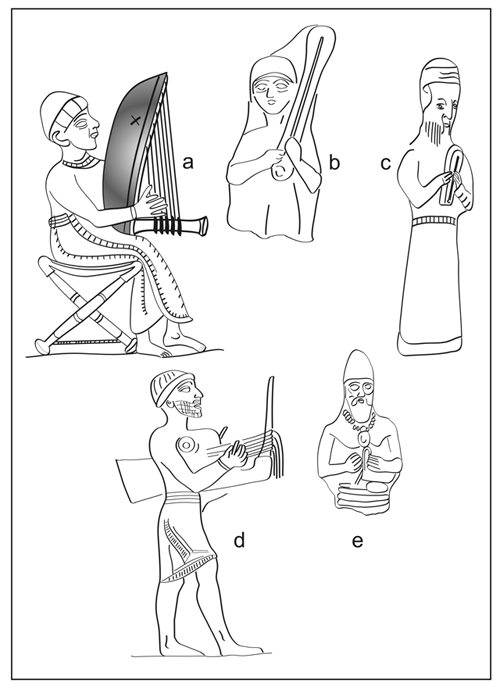
Figures 6a-6e: Angular harps from the 2nd millennium B.C.E. (Lawergren, 2001b, fig. 6). a. Side view of vertical model, Mesopotamia. b. Front view of vertical model, Mesopotamia. c. Front view of vertical model, Elam. d. Side view of horizontal model, Mesopotamia. e. Front view of harper but side view of his harp of an horizontal model, Elam (Encyclopedia Iranica).
In Elam, vertical harps were much smaller than in Mesopotamia, and always shown en face (FIGURE 6c). But unlike in Mesopotamia, horizontal harps were shown in side-views, with the players en face (FIGURE 6e). For this composite pose, the harp body was turned parallel to the player’s stomach. The horizontal harp was also smaller than the Mesopotamian instrument. But small harps were only a feature of the second millennium; afterwards Elamite harps had the same size as contemporary instruments everywhere else (see below iii.1-2). In eastern Iran, at Shahr-i Sokhta, a horizontal harp is shown during this period with normal size (Lawergren, “Harp,” fig. 4c).
(2) Rise of lutes in western Iran
Lutes exploit a different acoustic principle than harps and lyres. In the latter instruments, one string gives one pitch so that many strings are required for a range of pitches. But in a lute, many pitches are produced on a single string, and thus fewer strings are needed. The lute offered a more economical tone production, which quickly led to its dominance. The first lutes appeared 2300 B.C.E., a millennium after the first harps, in Mesopotamia. Another millennium later, lutes had become the dominant string instruments in Iran. Their body was 15 to 25 cm long, while their neck was twice as long as their short body.
For the first two millennia all lutes were long-necked. Lutes grew in size during the 2nd millennium B.C.E., though those from the first half were shorter than those from the second half (Lawergren, “Mesopotamien,” p. 158, figs. 22-23). On Iranian bronze beakers from the 10th to 9th centuries B.C.E., lutes were ca. 140 cm long (Muscarella, figs. 5 and 12). Short-necked lutes emerged between 100 B.C.E. and 100 C.E., and the length of their neck was less than half of that of their bodies. They are first depicted on gold jewelry at Tillya Tepe (Ṭelā Tapa) in southern Afghanistan (Sarianidi, p. 234, fig. 59, no. 2.29).
During the 1st millennium C.E., the popularity of lutes grew dramatically, and resulted in a large diversity of types. They spread through much the Islamic world, in particular Egypt, Iraq, and Iran, while the Aegean was swept up in the growing popularity of lutes in Europe.
On Susanian terracottas, lute players are often nude women and grotesque men. These figurines seem closer to folk art than to the royal art of Assyria and the Hellenistic ivory drinking horn (Gk. rhyton) of Parthia, on which very few lutes are depicted. Although lutes are not shown on elite artifacts during the 1st millennium B.C.E., they likely remained folk instruments, and migrated from Iran into western Central Asia. During the first millennium C.E., lutes probably spread from this vast Central Asian reservoir into eastern and southern Asia.
First millennium B.C.E.
(1) Harp ensemble at Madaktu, Elam, 650 B.C.E.
Angular harps continue to appear on the art of this period, and form the core of royal orchestras at Madaktu and Kul-e Farah. They are, for example, depicted in an Assyrian wall relief of King Ashurbanipal’s victory banquet, celebrating his defeat of the Elamite army at the town of Madaktu. (This site is not yet located with certainty, and Tepe Patak and Tepe Senjar have been suggested: Potts, Archaeology, p. 272; and idem, “Neo-Elamite Problems,” p. 170, respectively.) The scene shows how the court musicians depart from Madaktu (FIGURE 7b).
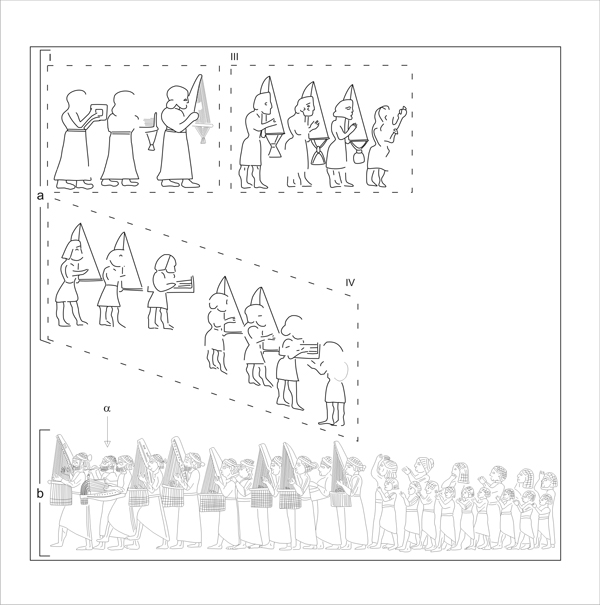
Figures 7a-7b: Angular harps, Elam, 1st millennium B.C.E. (Lawergren, “Iran,” fig. 7). a. Rock reliefs at Kul-e Faraḥ, near Izeh/Malāmir. b. Wall relief of Madaktu ensemble, Ashurbanipal’s Palace, Nineveh (see fig. 9c), 660–650 B.C.E (Encyclopedia Iranica).
On the panel, fifteen women and children march at the rear wailing and clapping hands. In front of them are eleven people with melody instruments: seven vertical angular harps, two horizontal angular harps (α), and two double-pipes. Although many instruments play simultaneously, one cannot conclude that harmony in the Western sense was present. More likely, they are joined heterophonically in a single melodic line (Sachs). Evidently, the provincial city of Madaktu was large enough to support a substantial court orchestra. One can only speculate about orchestras in Elam’s other political centers; the one in the capital Susa is likely to have been even larger.
(2) Harp ensembles at Kul-e Farah, Elam, 900-600 B.C.E.
The largest collection of Elamite musical instruments is documented at Kul-e Farah (FIGURE 1). The site lies in a valley surrounded by cliff walls carved with numerous reliefs, three of which show various groups of harps. Although some reliefs have eroded severely, surviving details allow for differentiating between the instruments (FIGURE 7a). While Panel I has been known since the beginning of the 20th century, panels III and IV were only published in the late 1980s (De Waele). Angular harps dominate, and all face right, but there is a remarkable variety of combinations of horizontal (H) and vertical (V) models:
Panel I: square frame drum + V + H
Panel III: V + V + V + singer / dancer ?
Panel IV: (H + V + V) + (H + V + V) + conductor
Since panel IV is drawn on an uneven surface, it is difficult to determine whether the group is one sextet or two trios, though the former interpretation seems more likely because of the conductor.
The harps of Kul-e Farah differ from other vertical angular models, for which the harps of Madaktu are typical, with regard to the various arrangements of tassels hanging from the rod. They seem to follow the vagaries of fashion. On panel I tassels are tied in a knot and flare into small pom-poms. On panel III, the knots are higher and more prominent, and the pom-poms’ flare is more pronounced. But on panel IV, there are no tassels at all.
(3) Secular music on the Arjan bowl, Elam, 620–580 B.C.E.
This large pictorial bowl of 43.5 cm diameter was found at Arjan in western Iran (FIGURE 1), and portrays royal activities. It is dated to the last period of the Elamite kingdom (Stronach, 2005, p. 179). The activities are shown in five concentric circles, and the fourth (FIGURE 10, reproduced as a linear frieze, distributed over several lines) is a scene of feasting with musical entertainment (Stronach, “Tomb”; Alvarez-Mon, pp. 224–26).
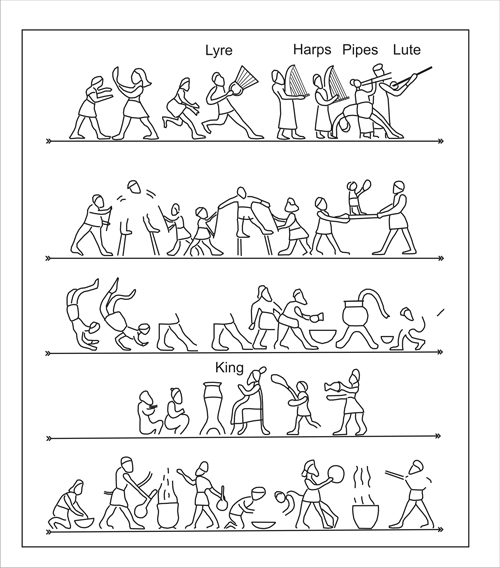
Figure 10: Musical scene from the Arjan bowl, and the five segments of this circle are presented in a linear sequence (Lawergren, 2001b, fig. 8) (Encyclopedia Iranica).
Most of the evidence discussed so far concerned music performed in religious contexts, but this lively scene has elements that point to a more secular setting. The king sits on a high throne. Before him stand various vessels, one of which has a drinking straw hanging over the edge. This jar may possibly contain an alcoholic beverage. Behind his back is the kitchen department with steaming pots, and attendants bring food to the king. He seems to be watching musicians and acrobats doing hand-stands and walking on stilts. One acrobat is doing a backward flip, next to the first group of musicians. Five instruments can be clearly recognized, moving from right to left: a lute, a double pipe, two vertical harps, a round-bodied lyre, and, perhaps, small percussion.
A similar scene with musicians, acrobats, and cooks appears on a much older Hittite vase from İnandık, dated to the middle of the 2nd millennium B.C.E. (Özgüç, fig. 64). But unlike the scene on the Arjan bowl, it also shows an altar, a sacrifice, and a copulating couple. These elements indicate a religious ceremony, even though it is unclear whether the music played was different from secular music.
(4) Achaemenid period, 550-331 B.C.E.
There is little contemporary information on music during this time. Drawing on later texts, M. Boyce (“Parthian Gōsān, pp. 20-21) concluded that minstrels had flourished and held privileged positions at court. Likewise, there is no pictorial Iranian evidence, but evidence for Achaemenid influence on Chinese instruments has recently emerged in China. The qin-zither of the Warring States period (5th-4th centuries B.C.E.) had a tuning key that was decorated with a bull-man resembling the large bull-men atop architectural pillars at Persepolis, the Achaemenid capital (Lawergren, “String Instruments,” p. 77). Another example are Chinese harps, which will be discussed below in section iv. First Millenium C.E. Such long-distance musical influences on China were facilitated by horse-riders traveling along the east-west expanse of the Eurasian steppes.
Greek writers have left much information on Achaemenid Persia, and some concerns music. Herodotus (5th century B.C.E.) remarked on Achaemenid priests who did not perform their rites to aulos music (Histories 1.132). In the Cyropaedia, Xenophon (ca. 430-after 356 B.C.E.), who had visited Persia in 401 B.C.E., told of the great number of singing women at the Achaemenid court (4.6.11; 5.1.1; 5.5.2; 5.5.39). Athenaios of Naucratis (3rd century C.E.?) mentioned a court singer who sang a warning to the king of the Medes of the acquisitive plans of Cyrus II (ca. 600-530 B.C.E. He also related that the Macedonian general Parmenio captured the 329 singing girls of the court of Darius III (ca. 380-mid-330 B.C.E.; Deipnosophistai 13.608) and that a royal officer at Babylon had 150 singing girls at his table (12.530). Because Greek writers are fairly unanimous, they should probably be trusted in their account of the many singing women. The tradition of woman musicians entertaining men continued in the Islamic period with the singing slave woman (Ar. qayna; see Pellat).
(5) Spread of Iranian harps throughout the Asian steppe zone
Both vertical and horizontal angular harps flourished in Iran and Mesopotamia, but the former dominated. The above mentioned reliefs at Madaktu and Kul-e Farah (FIGURE 7) reflect the Iranian use, and the number ratio of vertical to horizontal harps is 4:3. During the Achaemenid period angular harps spread east from this region along the steppe. Several examples have recently come to light in the Xinjiang Autonomous Region, China’s western borderland. But already half a century ago harps had been found at two widely dispersed locations: Pazyryk, near Bashadar, and Olbia in the Ukraine (FIGURE 8; Lawergren, 2003b, pp. 89-90).
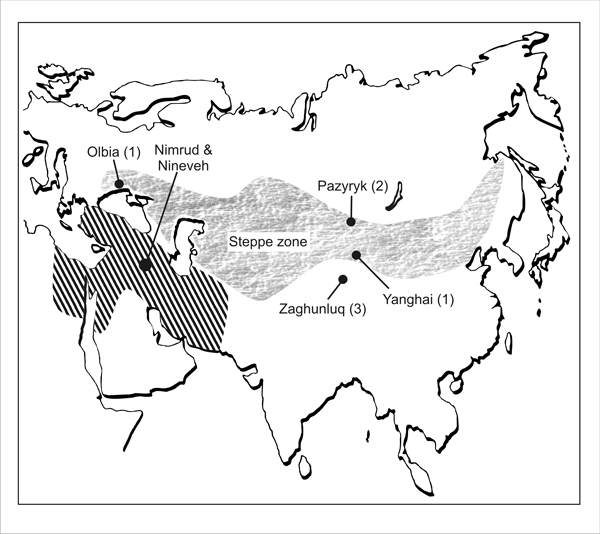
Figure 8: Map of the region where horizontal angular harps were played around 500 B.C.E., and the hatched area shows the Achaemenid empire (Lawergren, 2003b, fig. 10b) (Encyclopedia Iranica).
The Achaemenid empire controlled western Asia, and incorporated the heartland of the former Assyrian empire with its capitals Nimrud and Nineveh. In the Assyrian palaces, there are numerous depictions of horizontal harps (FIGURE 9a-c). Since these harp images were sculpted between 865 and 650 B.C.E., Assyrian instruments are likely to have served as models for the steppe harps, all of which are later than 500 B.C.E.; the Olbia harp is as late as 75 C.E. All harps found near the steppe zone are horizontal models, and have fewer than ten strings (FIGURE 9), whereas vertical harps have more than 20. This difference may explain why only horizontal harps traveled: instruments with fewer strings are less easily damaged.
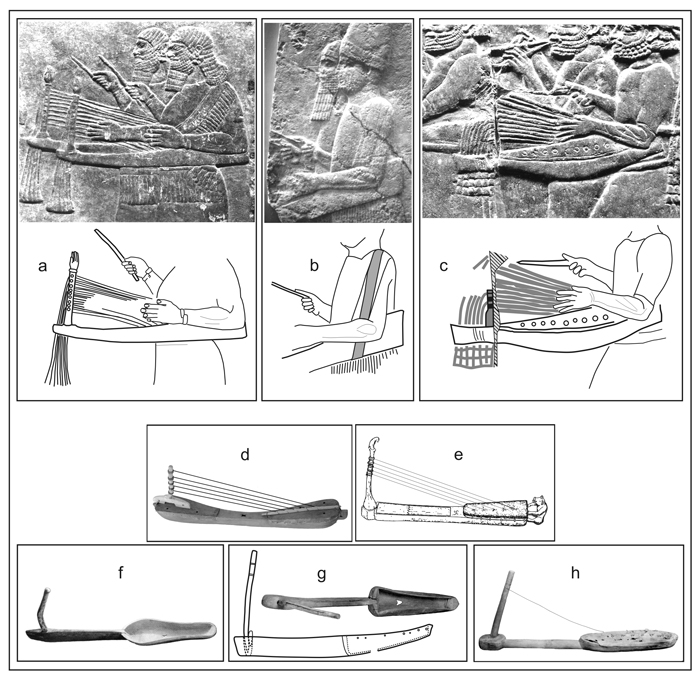
Figure 9a-9h: Horizontal harps of the 1st millennium B.C.E. (Lawergren, 2003b, fig. 11). a. Bas-relief, Palace of Ashurnasirpal II at Nimrud, ca. 865 (British Museum no. 124533). b. Bas-relief, Palace of Sennacherib at Nineveh, 705–681 (British Museum no. 124948). c. Bas-relief, SW Palace of Ashurbanipal at Nineveh, 660–650 (British Museum no. 124802; after Mitchell, 1980, fig. 22). d. Extant steppe harp, Pazyryk, Altai mountain region, 350. e. Extant steppe harp, Olbia, northern region of the Black Sea, 75 C.E. f. Extant steppe harp, Zughunluq, Qiemo county, Xinjiang Autonomous Region, 400–200. g. Extant steppe harp, Zughunluq, Qiemo county, Xinjiang Autonomous Region, 400–200. h. Extant steppe harp, Yanghai, Shanshan county, Xinjiang Autonomous Region, 1st millennium B.C.E (Encyclopedia Iranica).
Steppe harps resemble Achaemenid harps, and their body is that of a transformed, yet still recognizable Achaemenid instrument: a long box, often with a tapered end. But Central Asian harps differ from each other in details. In the Xinjiang harps, the body is half a box and half a solid rod (FIGURE 9f-h). The straight-sided body of the Pazyryk harp is waisted in the middle. The Elamite harp (FIGURE 9c) combines the taper with the rounded ends of the Pazyryk harp.
(6) Parthian period, ca. 250 B.C.E. to 224 C.E.
At the height of its power, the state of Parthia extended from Mesopotamia to the Indus. Texts and pictorial representations illuminate the prominent role of the gōsān (Parth. minstrel) in Parthian society. Their songs’ subject can be deduced from a fragment written a few centuries after the fall of the empire, when the language was still spoken:
“… like a gōsān, who proclaims the worthiness of kings and heroes of old” (Boyce, 1957, p. 11).
The Greek writer Strabo (ca. 64 B.C.E.-9 C.E.) noted that Parthians taught their young men songs about “the deeds both of gods and of the noblest men” (Geographica 15.3.18). According to Plutarch (ca. 46-ca. 120 C.E.), the gōsān praised Parthian heroes and ridiculed the Romans with equal gusto (Crassus 32.3). The Parthian minstrels influenced the Armenian courtly gusanner who sang heroic tales to the accompaniment of drums, pipes, lyres and trumpets (Boyce, 1957, pp. 13-14). Parthian songs probably continued to be performed, at least in the northeastern parts of greater Iran, long after the empire’s demise, and were absorbed into the Iranian national epic Šāh-nāma, composed by Ferdowsi (940-1019 or 1025).
To the bewilderment of the Romans, the Parthian army used large drums (Gk. rhoptron, pl. rhoptra) to prepare for battle: “they had rightly judged that, of all the senses, hearing is the one most apt to confound the soul, soonest rouses its emotions, and most effectively unseats the judgment” (Plutarch, Crassus 23.7). Many instruments mentioned in the surviving texts are also depicted in Parthian art, and most appear to have been derived from Hellenistic models known in Greece, Rome, and Egypt. The most magnificent depictions are carved on ivory drinking horns of the 2nd century B.C.E., found at the ancient Parthian capital of Nisa, near Ashkhabad in Turkmenistan (Colledge, fig. 2; Karomatov, pp. 54-59) but probably made in Bactria (Boardman, p. 90). These carvings show how aulos, kithara, and syrinx were played at Dionysian dances, ritual processions, and sacrificial offerings, as well as at theatrical performances.
Musicians are also commonly depicted on terracotta plaques; one, for example, portrays a female harp player (Colledge, pl. 20d). Similar plaques from Babylon show harp, lute, tambourine, syrinx, lyre, and clapper (Karvonen-Kannas, nos. 277-336). Several bronze statuettes from Dura Europus (Qalʿat al-Ṣāliḥiya in contemporary Syria) on the Euphrates show a double aulos and unusually long syrinx. Bone tablets from the 1st or 2nd centuries C.E., attributed to Olbia, depict female dancers, musicians, and acrobats. A temple at Hatra (al-Ḥadr in contemporary Iraq) dedicated to Sun, Moon, and the goddess Atargatis, has a stone frieze, dated 2nd century C.E., with a wedding procession. Among the celebrants is a singer surrounded by musicians playing tambourines, a 13-pipe syrinx, a transverse flute, double and single reed pipes, and a trumpet (Rashid, pp. 156-65).
iv. First millennium C.E.
(1) Sasanian music, 224-651.
The evidence for Sasanian music, in particular within the context of Zoroastrian ritual, is more substantial than that for music of earlier eras. Zoroastrianism had already been adopted as the state religion by the Achaemenids, and the Sasanians restored this status after a brief interlude of Hellenism under the Parthians.
The Zoroastrian Vendīdād, which is part of the Avesta, has been mentioned above in connection with the Oxus trumpet. But the Avesta’s earliest parts are the five Gathas, some of which go back to the 2nd millennium B.C.E. (Boyce, Textual Sources, p. 8; Mallory, p. 37). They are hymns similar to the Vedic Samhitās, which are known to have been sung or chanted (Gonda, pp. 313-16). Although there is no direct evidence that the Gathas were sung, songs played a prominent role in early Zoroastrian imagination, and it seems likely that the Gathas were chanted. Herodotus claimed that Zoroastrian magi chanted at sacrifices (Histories 1.132). Some silver bowls, which will be discussed below, are decorated with musical scenes (Duchesne-Guillemin, “Les instruments,” pp. 50–80). The Zoroastrian paradise (Pahlavi garōdmān) was known as the “House of Song” (Boyce, Textual Sources, p. 28; see also FIGURE 12), where music induced perpetual joy. Similar ideas also entered Mahayana Buddhism whose sutras glowingly describe music as one of the chief delights of paradise (Lawergren, “Buddha,” pp. 234-38). For Zoroastrians, this music begins when a righteous person dies, and the soul leaves the body to chant for three days (Boyce, Textual Sources, p. 81).
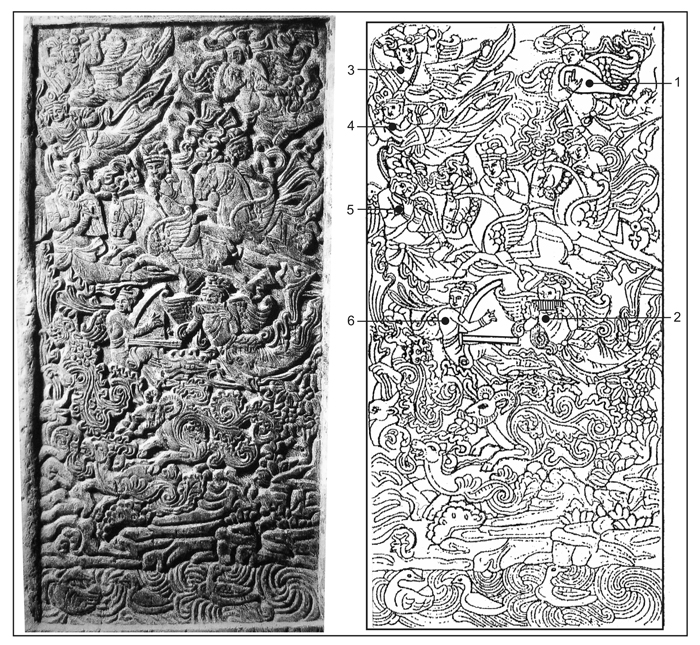
Figure 12: Paradise, east side of the stone sarcophagus of Shi Jun, Xi’an, Shaanxi Province, China, 580 C.E. (Institute of Archeology of Xi’an, p. 20 left side); relief and line drawing (Encyclopedia Iranica).
Although no instruments were used in formal worship, Zoroastrians used them to add a convivial element to the celebrations of holy days, “putting to rout, for a moment at least, the gloomy forces of darkness” (Boyce, Zoroastrianism, p. 104). A Muslim scholar observed that pillars were built before the time of Nowruz:
“One column was sown with wheat, one with barley, another with rice, the other ones with lentils, beans. . . millet, sorghum . . . . And the harvest thereof was never gathered but with song and music and mirth, which happened on the sixth day after the beginning of No Roz (sic).” (Boyce, Textual Sources, p. 70)
According to the Arab author Masʿudi (d. 956), music was greatly esteemed at court, and Ardašir I (d. 242), the founder of the Sasanian dynasty, gathered singers, minstrels and musicians into a special courtly class (Boyce, “Parthian Gōsān,” p. 22). Two centuries later, Bahrām V Gōr (r. 420-38) elevated this class to the highest rank (Christensen, p. 31). He was fond of music, and recruited 12,000 singers from India. But music was even more highly cherished by Ḵosrow II (r. 590-628), whose reign was a veritable Golden Age of Iranian music. He is shown among musicians on a large cliff relief at Ṭāq-e Bostān in western Iran. The king, holding bow and arrows, stands in a boat amidst a band of harpists. Another group of harpists is seated in a second boat, while numerous musicians play on a platform at the shore. It is a remarkable scene because the boats are shown at two successive moments within the same panel, and the harps are rendered in considerable detail.
There are many tales about the musicians at Sasanian courts. Since these were illustrated in hundreds of manuscripts centuries later, the stories are as important to Persian musical iconography as the Bible to the European Middle Ages. Most stories were recorded in the above mentioned Šāh-nāma, and some may be rooted in reality. Other literary sources are Haft peykār (lit. Seven portraits or beauties) and Ḵosrow o Širin in the Ḵamsa, the posthumous collection of five romances by Neẓāmi Ganjavi (1141-1209).
In the Haft Peykar Bahrām V Gōr falls in love with one of his slave women, the Byzantine harpist Fetna (see ĀZĀDA). They became the most popular musical image of Persia in both Sasanian art after 650 and Persian miniature paintings between about 1300 and 1600 (Ettinghausen, p. 29). Another story tells how Bārbad, the legendary sweet-voiced lutenist outwitted the envious harpist Sarkaš (or Sargis), the chief court minstrel of Ḵosrow II. Bārbad is assumed to have been an historical person, and a variety of later sources affirm his fame as composer and lutenist, calling him the founder of Persian music. According to one tradition, Bārbad died from poisoning at the hand of his rival Sarkaš, who had stayed on as a minor court musician.
Although little literary evidence has survived, some insight into the nature of Sasanian music may be gained from Muslim authors, such as the astronomer and physician Qoṭb-al-Din Širāzi (d. 1311). He mentioned seven musical modes were recognized during the Sasanian era, including sakāf, mādārusnān, sāykād, sisum, and jubarān; these names lack musical significance and are probably corrupt (Farmer; for a tentative translation, see Christensen, p. 38). Qoṭb-al-Din also asserted that Bārbad composed seven royal modes (Pers. ḵosrovāni), 30 derivative modes (Ar. laḥn) one for each day in the Zoroastrian month, and 360 melodies or airs (Pers. dāstān), one for each day of the Zoroastrian year, neglecting the five intercalary days. Neẓāmi named some tunes, but did not provide the lyrics. A manuscript, found at Turfan in the Xinjiang Autonomous Republic, China, may contain the words of a poem composed and sung by Bārbad or one of his contemporaries (Christensen, pp. 44-45). The text of four lines, each with eleven syllables, was found in a trove of Manichean manuscripts, and the song Xwaršēδ ī rōšan (lit. The shining sun) is written in the Pahlavi language that was used at the time of Bārbad:
The shining sun, the beaming full moon, resplendent and beaming behind the trunk of a tree; the eager birds strut about it full of joy, the doves and the colorful peacocks strut about.
The beginning is reminiscent of the name of the Sasanian melody The beauty of the sun (MPers. Ārāyišn ī xwaršeδ), mentioned by Muslim authors. The small difference could have arisen when the Muslim authors translated Pahlavi into Persian (Christensen, pp. 44-45).
(2) Sasanian instruments
The Sasanians employed a large number of instruments, many of which are known only in name. In the story known as “King Ḵosrow and his Boy” (Unvala, pp. 62-63) the king asks, “Which musician is the finest and the best?” and the boy diplomatically mentions the players of all instruments known to him: čang (which he distinguishes as the foremost instrument), vin, vinkannār, moštaq, tambur, barbaṭ, nād, dombalak, raṣn and 16 others. The čang is the harp, but many others are as yet unidentified, and homophony of names does not provide reliable evidence. Barbaṭ, for example, has often been translated barbitos (e.g., Boyce, “Parthian Gōsān, p. 23); but the latter is an ancient Greek lyre not used after 400 B.C.E., and the barbaṭ cannot be the barbitos, although the name may be of Greek origin, probably via Byzantium.
Iconographic sources provide more reliable information, and silver vessels are among the richest sources. Aerophones included the reed pipe (Pers. sornā). The Chinese mouth organ (Pers. moštaq)— shown on a wall relief from Taq-e Bostān and on a silver cup from Kalār Dašt, Māzandarān (6th century C.E., Archeological Museum, Tehran)—flourished briefly in Iran. It has five to seven pipes in a wind reservoir with finger holes and reeds. Like some other foreign instruments and instrumental details, the mouth organ probably owed its introduction to traffic along the Silk Route. String instruments were the horizontal angular harp (possibly Pers. vin), the short-necked lute (Pers. barbaṭ), which has four and six strings, and the light vertical angular harp (Pers. čang), which could have been invented in Iran, Central Asia or China. The membranophones included the kettledrum (Pers. kūs), small drum (Pers. ṭās), frame drum, and hourglass drum (Pers. kūba), which is related to Central Asian drums. To the idiophonic group belonged the forked cymbals (Pers. čaḡāna), related to Roman cymbals, and pairs of wooden clappers or castanets (Pers. čahār pāra).
(3) Sogdian instruments in China
Between the 3rd and 8th centuries, the Sogdian heartland comprised Bukhara, Samarqand, Panjikant, and Tashkent. Sogdians spoke a Middle-Iranian language, had adopted Zoroastrianism, and used instruments similar to those in Iran. Wall paintings in Panjikant show settings and instruments familiar from Iran, and lutes, angular harps, flutes, and hourglass drums were illustrated. A few foreign instruments are also present in Panjikant: the arched harp came from India, and the lyre from the Hellenistic area. The ensembles are small with one to three instruments.
Sogdians were the most active traders on the Silk Road , and their language became its lingua franca. Sogdian merchants settled in China, maintained Sogdian habits, and decorated their sarcophagi and funerary beds with scenes of mythology and daily life, including music making. These monuments have become an important source on their music, richer than anything in the home country. The funerary monuments in China are either closed stone sarcophagi or open stone beds. Both types display scenes related to the interred person. Hunting scenes, banquets, Zoroastrian imagery, such as fire altars, and music making were common subjects. Epitaphs give names and dates. The names are often Sogdian, the title sabao (Chin. caravan leader) is common, and the dates refer to the last quarter of the sixth century.
The music scenes depict instruments typical of Sogdia. Lutes, angular harps, flutes, and hourglass drums are the core of Sogdian instruments, and they were remembered in China. So was the vigorous Sogdian dance with bent legs. But the arched harp and the lyre were never shown on Sogdian monuments in China. The preference for small groups was retained by Sogdians in China.
So far there are four properly excavated monuments (Lerner, p. 52), and most show orchestras. Clearly, émigré Sogdians loved music. An example is the tomb of Shi Jun and his wife.
The tomb is entered through a gate decorated with seven musical instruments: two lutes, a panpipe, a conch trumpet, a vertical angular harp, a flute, and a pipe. The tomb contains a house-shaped stone sarcophagus. Its entrance door occupies the center of the wide southern side, and the typical Zoroastrian fire altars attended by priestly bird-men are placed on either side. A row above the door shows kneeling musicians, four on each side (FIGURE 11). They are playing, moving from left to right, panpipes, a flute, a lute, a vertical angular harp, a lute, a waisted drum, an undetermined object, and a pipe—again seven instruments. Since attendants and musicians face the door, they probably act in concert and their instruments form one single ensemble. Since the septet plays near fire altars, we may consider their music Zoroastrian.

Figure 11: South side of the stone sarcophagus of Shi Jun, Xi’an, Shaanxi Province, China, 580 C.E. (Institute of Archeology of Xi’an, p. 19) (Encyclopedia Iranica).
The short eastern side of the sarcophagus has three scenes, two of which are joined by an arched bridge. This is the Činwad Puhl, over which righteous souls pass into the Zoroastrian paradise (FIGURE 12), the earlier mentioned House of Song. On it winged musicians who swirl in a maelstrom of other winged creatures—similar to apsarasesin Indian and Buddhist art—play several instruments: A vertical angular harp, a flute, a lute, panpipe, and possibly small cymbals. This ensemble spreads out across the scene, and several horses gallop right through it. Evidently, the House of Song was thought to contain instrumental music. But no mouths are open, and so there would have been little song.
Master Shi’s sarcophagus gives the first evidence of Zoroastrians imagined instruments in paradise. Beside the two orchestras, Shi’s sarcophagus has four other orchestras. On the average, there are 5.3 “instruments per orchestra” (or “size of the orchestra”).
(4) Chinese inventories of Sogdian orchestras.
Chinese dynastic histories provide another view of Sogdian émigré orchestras. They give the names of instruments and the size of foreign orchestras present in the Chinese capital during the Sui (581–618) and Tang (618–907) dynasties. Western translations, given by Courant (pp. 192–201) and Liu (pp. 201–209), simplify many idiosyncratic names, especially those of percussion instruments. But the original names are conveniently supplied by Yin (pp. 9–11). Considering the diversity and precision in the Chinese names, we may assume the accounts to be factual. Here, however, I will only count sizes.
According to the histories, most of the orchestras were large, with more than 20 instruments. In contrast, ensembles from Sogdia (i.e., Samarqand and Bukhara) are said to have comprised seven or eight instruments, less than half, so that they had been the smallest. They had two types of drums, called straight and harmonizing; both are probably waisted drums of different size, since two sizes are in fact shown on funerary monuments. The other instruments are a four-stringed and a five-stringed lute, a harp, two flutes, and a pair of cymbals, and all are often shown on Sogdian monuments. The relatively small number of instruments agrees with the low number depicted. In these histories, Sogdian ensembles are the only orchestras not dominated by percussion. In this respect, the texts also agree with the depictions on funerary monuments and on images from Sogdia and Iran. The only exception is a large orchestra playing at Ṭāq-e Bostān, but the situation is special because Chinese and Iranian instruments appear at an unusually large royal celebration.
Bibliography
J. Alvarez-Mon, “Imago Mundi: Cosmological and Ideological Aspects of the Arjan Bowl,” Iranica Antiqua 39, 2004, pp. 203-37.
J. Black and A. Green, Gods, Demons and Symbols of Ancient Mesopotamia: An Illustrated Dictionary, London, 1992.
J. Boardman, The Diffusion of Classical Art in Antiquity, London, 1994.
M. Boyce, “The Parthian Gōsān and Iranian Minstrel Tradition,” JRAS 9, 1957, pp. 10-45.
Eadem, ed. and tr., Textual Sources for the Study of Zoroastrianism, Manchester, 1984.
Eadem, Zoroastrianism: Its Antiquity and Constant Vigour, New York, 1992.
A. Christensen, “La vie musicale dans la civilisation des Sassanides,” Bulletin de l’Association Française des Amis de l’Orient, 1936, pp. 24-45.
M. A. R. Colledge, The Parthians, New York, 1967.
M. Courant, “Chine et Corée,” Encyclopédie de la musique et dictionnaire du Conservatoire, pt. 1, vol. 5, pp. 77-211.
E. De Waele, “Musicians and Musical Instruments on the Rock Reliefs in the Elamite Sanctuary of Kul-e Farah (lzeh),” Iran 27, 1989, pp. 29-38.
J. Duchesne-Guillemin, “Cor de Yima et trompette d’Isrāfīl: De la cosmogonie mazdéenne à I’eschatologie musulmane,” in Comptes rendus des séances de l‘Académie des inscriptions et belles-lettres, Paris, 1979, pp. 539-49.
Idem, “Les instruments de musique dans l’art Sassanide,” Iranica Antiqua Suppl. VI, 1993.
S. Dunham, “An Early Percussion Instrument from Tell al-Raqāʿi, North Syria,” Source, 13, no. 4, 1994, pp. 36-43.
R. Ettinghausen, “Bahram Gur’s Hunting Feats or the Problem of Identification,” Iran, 17, 1979, pp. 25-31.
H. G. Farmer, “The Old Persian Musical Modes,” JRAS, 1926, pp. 93-95; repr. in Studies in Oriental Music, ed. E. Neubauer, Frankfurt/Main, 1997, vol. 2, pp. 426-32.
R. N. Frye, The Heritage of Persia, London, 1962.
J. Gonda, Vedic Literature: Samhitas and Brahmanas, Wiesbaden, 1975.
F. Grenet et al., “Zoroastrian Scenes on a Newly Discovered Sogdian Tomb in Xi’an, Northern China,” Stud. Ir. 33, 2004, pp. 273-84.
A. Hakemi, Shahdad, tr. S. M. S. Sajjadi, Rome, 1997.
F. Hiebert, “Production Evidence for the Origins of the Oxus Civilization,” Antiquity 68, 1994, pp. 372-87.
Institute of Archeology of Xi’an, “Excavation of the Sabao Shi’s Tomb of the Northern Zhou Dynasty near Xi’an,” Wenwu chunqiu, 2005, no. 3, pp. 4-33, in Chinese.
F. M. Karomatov et al., Mittelasien, Musikgeschichte in Bildern II, 9, Leipzig, 1987.
K. Karvonen-Kannas, The Seleucid and Parthian Terracotta Figurines from Babylon in the Iraq Museum, the British Museum, and the Louvre, Florence, 1995.
B. Lawergren, “Buddha as a Musician,” Artibus Asiae, 54, 1994, pp. 226-40.
Idem, “Mesopotamien,” Die Musik in Geschichte und Gegenwart, 2nd ed., Sachteil, VI (1997), col. 143–71.
Idem, “String Instruments,” in Music in the Age of Confucius, ed. J. F. So, Seattle, 2000, pp. 65-83.
Idem, “Harp (ancient),” New Grove Dictionary of Music and Musicians, 2nd ed., X, pp. 881-88 and 894-96.
Idem, “Iran (ancient),” New Grove Dictionary of Music and Musicians, 2nd ed., XII, pp. 521–30; Persian tr., Mahoor Music Quarterly 28, 2005, pp. 39-57.
Idem, “Oxus Trumpets, ca. 2200-1800 BCE: Material Overview, Usage, Societal Role, and Catalog,” Iranica Antiqua 38, 2003, pp. 41–118.
Idem, “Western Influences on the Early Chinese Qin-Zither,” Bulletin of the Museum of Far Eastern Antiquities 75, 2003, pp. 79–109.
B. Lawergren and O. R. Gurney, “Sound Holes and Geometrical Figures: Clues to the Terminology of Ancient Mesopotamian Harps,” Iraq 69, 1987, pp. 37-52.
J. A. Lerner, Aspects of Assimilation: The Funerary Practices and Furnishings of Central Asians in China, Sino-Platonic Papers 168, Philadelphia, 2005.
Liu Mau-Tsai, Kutscha und seine Beziehungen zu China vom 2. Jh. v. bis zum 6. Jh. n. Chr., Asiatische Forschungen 27, Wiesbaden, 1969.
Y. Majidzadeh, “The Arjan Bowl,” Iran, 30, 1992, pp. 131-44.
J. P. Mallory, In Search of the Indo-Europeans; Language, Archaeology and Myth, London, 1989.
J. P. Mallory and V. H. Mair, The Tarim Mummies; Ancient China and the Mystery of the Earliest Peoples from the West, London, 2000.
T. C. Mitchell, “An Assyrian Stringed Instrument,” in Music and Civilization,British Museum Yearbook 4, London, 1980, pp. 33-42.
O. W. Muscarella, “Decorated Bronze Beakers from Iran,” American Journal of Archaeology, 78, 1975, pp. 239-54.
T. Özgüç, İnandıktepe: An Important Cult Center in the Old Hittite Period, Ankara, 1988.
A. Parrot, Les temples d’Ishtarat et de Ninni-Zaza, Mission archaéologique de Mari 3, Paris, 1967.
C. Pellat, “Kayna,” EI² IV, pp. 820-24.
E. Porada, The Art of Ancient Iran: Pre-Islamic Cultures, New York, 1965.
D. T. Potts, The Archaeology of Elam, Cambridge, 1999. Idem, “Neo-Elamite Problems,” Iranica Antiqua 40, 2005, 165-77.
S. A. Rashid, Mesopotamien, Musikgeschichte in Bildern II, 2, Leipzig, 1984.
M. L. Rostovtzeff and P. V. C. Baur, eds., The Excavations at Dura-Europos: IX– Preliminary Report of the Ninth Season of Work, 1935-1936, vol. I, New Haven, 1944.
C. Sachs, “Heterophonie,” Die Musik in Geschichte und Gegenwart, 1st ed. VI (1957), col. 327-30.
V. Sarianidi, The Golden Hoard of Bactria: From the Tillya-Tepe Excavations in Northern Afghanistan, New York, 1985.
A. Spycket, “La musique instrumentale mésopotamienne,” Journal des savants, 1972, pp. 153–209.
D. Stronach, “The Tomb at Arjan and the History of Southwestern Iran in the Early Sixth Century BCE,” in Yeki Bud, Yeki Nabud; Essays on the Archaeology of Iran in Honor of William M. Sumner, ed. N. F. Miller and K. Abdi, Los Angeles, 2003, pp. 249-59.
Idem, “The Arjan Tomb: Innovation and Acculturation in the Last Days of Elam,” Iranica Antiqua 40, 2005, pp. 179-96.
J. M. Unvala, ed. and tr., King Husrav and his Boy, Paris, 1917.
Yin Falu, Tang Song da qu zhi lai yuan ji qi zhi, Beijing, 1948.

